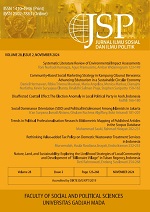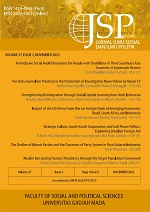Understanding New Consumption Sites of Internet Cafe in Yogyakarta, Indonesia
Tangguh Okta Wibowo(1), Wening Udasmoro(2*), Ratna Noviani(3)
(1) Doctoral Student at Department of Media and Cultural Studies, The Graduate School, Universitas Gadjah Mada
(2) Department of French Literature, Faculty of Cultural Sciences, Universitas Gadjah Mada
(3) Department of Media and Cultural Studies The Graduate School, Universitas Gadjah Mada
(*) Corresponding Author
Abstract
In the Indonesian context, we did not find any previous study on internet cafes that discussed the transformation from warnet to internet cafe. Based on our study in Yogyakarta, we found a new internet cafe style that we did not find in other cities. This study offers a new understanding of analyzing internet cafes that users not only consume a computer to access the internet, but they “consume” space as well. This study aims to explore that transformation and to reveal the expansion of consumption patterns. This study emphasizes the empirical investigation to gather the data. We conducted qualitative in-depth interviews and observations from January to June 2018. We also examined several previous studies about internet cafes to expose a gap that can be extended in this study. Based on findings, we found that the transformation from warnet was a way to survive amid mobile technology. This transformation gives an implication to the new means of consumption. However, the expansion of consumption patterns can be explored from the consumption of space and digital content. Overall, digital content is the new insight to understand that internet cafes are not only a place to copy contents, but this can be seen as a symbol of empowerment to local users. Therefore, internet cafes can be seen as media-industry bottom lines to promote a culture of resistance to digital content without going to the store or going to the cinema.
Keywords
Full Text:
PDFReferences
Anshari, I. N. (2014a). All you can copy: rekomodifikasi dalam budaya mengopi video di warnet. Membayangkan Indonesia Baru, 548–559. Retrieved from https:// ww.academia.edu/12772771/All_You_ Can_Copy_Rekomodifikasi_Dalam_ Budaya_Mengopi_Video_Di_Warnet
Anshari, I. N. (2014b). Pemahaman baru pembajakan digital dalam budaya mengopi: praktik dan implikasi budaya mengopi video di warnet di Yogyakarta. Thesis. Universitas Gadjah Mada.
Anshari, I. N. (2017). “Ngopi film di warnet”: sirkulasi film dalam lingkup media baru (copying movies in internet kiosk: the circulation of movies in the scope of new media). Konferensi Film Indonesia. Retrieved from Unpublished material.
Åst røm, J. K. (2019). Why t heming ? identifying the purposes of theming in tourism. Journal of Quality Assurance in Hospitality & Tourism, 0(0), 1–22. doi: 10.1080/1528008X.2019.1658147
Benjamin, W. (2001). The work of art in the age of mechanical reproduction. In G. D. Meenakshi & K. Douglas (Eds.), Media and cultural studies (pp. 18–40). London: Blackwell.
Binark, M., Sütcü, G. B., & Buçakçı, F. (2009). How Turkish young people utilize internet cafes: the results of ethnographic research in Ankara. Observatorio (OBS*) Journal, 3(1), 286–310. doi: 10.15847/obsOBS312009249
Crow, G., & Wiles, R. (2008). Managing anonymity and confidentiality in social research: the case of visual data in Community research. Retrieved from http://eprints.ncrm.ac.uk/459/
Featherstone, M. (2007). Consumer culture and postmodernism (2nd ed.). London: Sage Publications.
Goenawan, M. A. (2018). ESports bikin warnet naik kelas. Retrieved August 8, 2018, from Detik.net website: https://inet.detik.com/ games-news/d-3834822/esports-bikin- warnet-naik-kelas.
Gürol, M., & Sevindik, T. (2006). Profile of internet cafe users in Turkey. Telematics and Informatics, 24(1), 59–68. doi: 10.1016/j. tele.2005.12.004
Hill, D. T., & Sen, K. (1997). Wiring the warung to global gateways: the internet in indonesia. Indonesia, 63, 67–69. doi: 10.2307/3351511
Hill, D. T., & Sen, K. (2005). The Internet in Indonesia’s New Democracy. New York: Routledge
Hindarto, S. Y. (2008). Warnet masih jadi sarang mesum pelajar (internet kiosk is still a student’s nasty nest). Retrieved February 23, 2019, from Oketechno website: https://techno.okezone.com/ read/2008/12/01/55/169378/warnet-masih- jadi-sarang-mesum-pelajar )
Hjorth, L. (2007). Snapshots of almost contact: the rise of camera phone practices and a case study in seoul, korea. Continuum, 21(2), 227–238. doi: 10.1080/10304310701278140
Hyde-Clarke, N. (2006). The urban digital divide: a comparative analysis of internet cafés in Johannesburg, south africa. Review of African Political Economy, 33(107), 150–156. Retrieved from https://www. jstor.org/stable/4007119
Laegran, A. S. (2009). Technosocial space: connecting people and places. In P. Turner, S. Turner, & E. Davenport (Eds.), Exploration of Space, Technology, and Spatiality: Interdisciplinary Perspectives (pp. 54–69). doi: 10.4018/978-1-60566-984-7.ch072
Laegran, A. S., & Stewart, J. (2003). Nerdy, trendy or healthy? configuring the internet café. New Media and Society, 5(3), 357–377. doi: 10.1177/14614448030053004
LeBlanc , M., & Shrum, W. (2017). The evolution of ghanaian internet cafés, 2003–2014. Information Techn ology for Development , 23 (1), 86–106. doi: 10.1080/02681102.2016.1263594
Lee, S. (1999). Private uses in public: a study of an internet cafe. New Media & Society, 1(3):331–350. doi: 10.1177/14614449922225618
Leon, K. J. L. (2007). Philippine sociological society a study of internet cafés: identity, freedom and communicative extension. Philippine Sociological Review, 55, 37–49. Retrieved from https://www.jstor.org/ stable/23898244
Lessig, L. (2004). Free Culture: How Big Media Uses Technology and the Law to Lock Down Culture and Control Creativity. United States: Penguin Press.
Liff, S., & Laegran, A. S. (2003). Cybercafes: debating the meaning and significance of internet access in a cafe environment. New Media & Society, 5(3), 307–312. doi: 10.1177/14614448030053001
Lim, M. (2003a). From war-net to net-war: the internet and resistance identities in indonesia? International Information and Library Review, 35(2–4), 233–248. doi:10.1080/10572317.2003.10762603
Lim, M. (2003b). The internet, social networks, and reform in indonesia. In N. C. and J. Curran (Ed.), Contesting Media Power: Alternative Media in a Networked World (pp. 273–288). Lanham, MD: Rowman & Littlefield Publishers, Inc.
Müller, J., & Kirleis, W. (2019). The concept of socio-environmental transformations in prehistoric and archaic societies in the holocene: an introduction to the special issue. The Holocene, 29(10), 1517–1530. doi: 10.1177/0959683619857236
Mutula, S. M. (2003). Cyber cafe industry in africa. Journal of Information Science, 29(6), 489–497. doi: 10.1177/0165551503296006
Ohmae, K. (1995). The end of the nation state: The rise of regional economies. New York: Free Press.
Ozdemirci, E. G. (2014). Bit torrent: stealing or sharing culture? a discussion of the pirate bay case and the documentaries “steal this film” I & II. In F. Martin & A. James (Eds.), Piracy: Leakages from Modernity. California: Litwin Books.
Pickering, M. (Ed.). (2008). Research methods for cultural studies. Edinburgh: Edinburgh University Press Ltd.
Piliang, Y. A. (2010). Dunia yang dilipat: Tamasya melampaui batas-batas kebudayaan. Bandung: Matahari.
Portus, L. M. (2015). Internet literacy : levels of literacy among selected filipinos across economic classes. Plaridel Journal, 12(1), 158–179.
Pratt, A. C. (2002). Hot jobs in cool places: the material cultures of new media. In Cybercultures: Critical Concepts in Media and Cultural Studies. New York: Routledge.
Qiu, J. L. (2013). Cybercafés in china: community access beyond gaming and tight government control. Library Trends, 62(1), 121–139. doi: 10.1353/lib.2013.0021
Räisänen, P. (2006). The urban technospace: a study on internet cafés in Shanghai. Thesis. Lund University. Retrieved from https:// lup.lub.lu.se/student-papers/search/ publication/1327545
Strangelove, M. (2015). POST-TV Piracy , Cord-Cutting, and the Future of Television. Toronto: University of Toronto Press.
Tarigan, S. (2018). Warnet jadi tempat mesum siswa, terungkap saat petugas melakukan razia (internet kiosk becomes student’s nasty place, revealed when officers conduct raids). Retrieved February 23, 2019, from Tribun Medan website: http://medan. tribunnews.com/2018/09/08/warnet-jadi- tempat-mesum-siswa-terungkap-saat- petugas-melakukan-razia)
Tyron, C. (2013). On-demand culture: digital delivery and the future of movies. New Brunswick: Rutgers University Press.
Urry, J. (1995). Consuming places. London: Routledge.
Warner, J., Talbot, D., & Bennison, G. (2012). The cafe as affective community space: reco nce ptualizing care and emotional labour in everyday life. Critical Social Policy, 33(2), 305–324. doi:10.1177/0261018312449811
Wibowo, T. O. (2019). Understanding movie streaming web sites in indonesia as unlimited movie access in the digital era. Jurnal Komunikasi: Malaysian Journal of Communication, 35(2), 247–259. doi:10.17576/JKMJC-2019-3502-15
Article Metrics
Refbacks
- There are currently no refbacks.
Copyright (c) 2020 Jurnal Ilmu Sosial dan Ilmu Politik

This work is licensed under a Creative Commons Attribution-NonCommercial-NoDerivatives 4.0 International License.























